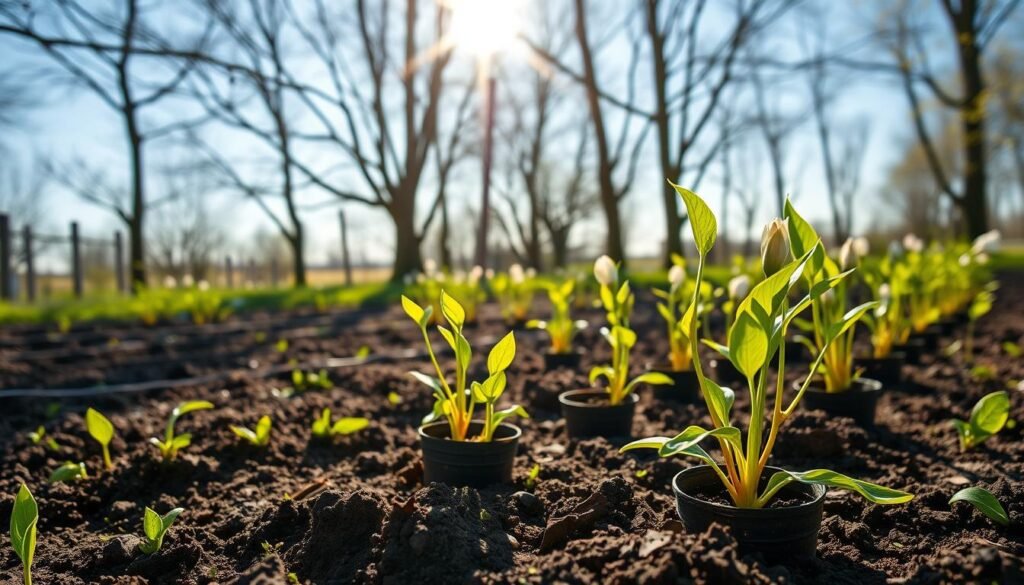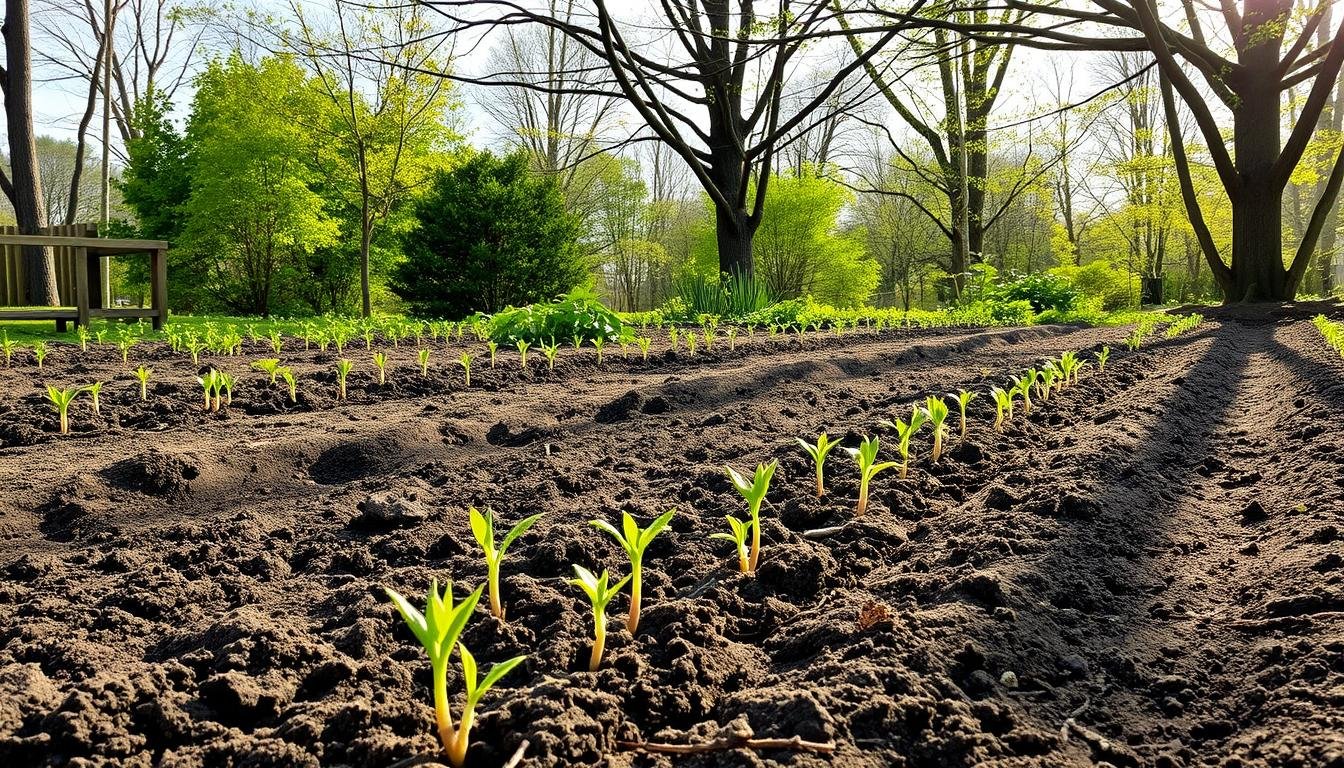Knowing when to plant Siberian Ginseng in Michigan is key for its growth. This hardy herb is great for health and grows best in certain seasons. I’ll share how to grow Siberian ginseng in Michigan, including the best time to plant, climate tips, and care advice.
Key Takeaways
- The ideal planting times for Siberian ginseng are spring and early fall.
- Seeds should be planted at a depth of 1/4 inch to 1/2 inch.
- Fall planting allows for stronger root development in spring.
- It prefers morning sun and afternoon shade for optimal growth.
- Regular watering and fertilizing with organic matter like compost are essential.
- Annual pruning in late winter or early spring enhances plant health.
- Good air circulation helps to prevent common pests and diseases.
Table of Contents
Understanding Siberian Ginseng
Siberian Ginseng, also known as Eleutherococcus senticosus, is a tough perennial herb. It’s often confused with true ginseng. This plant comes from Eastern Asia’s temperate forests.
It’s valued in herbal medicine for boosting stamina, lowering stress, and strengthening the immune system. If you’re into siberian ginseng cultivation michigan, knowing its needs is key.
For a siberian ginseng growing guide, note it needs certain conditions. It likes sandy loam soil with a pH of 5.0 to 6.5. This helps it avoid diseases and absorb nutrients well.
The best temperature for it is around 50 degrees Fahrenheit. It can handle some cold. This makes it good for Michigan.
Siberian Ginseng grows well in shady spots, especially on slopes facing East or North. It needs 60 to 90 percent shade. Knowing these basics can help you grow it successfully.
Remember, there are rules for growing ginseng that vary by state. Following these laws is important. It helps keep farming sustainable and responsible. As ginseng demand rises, learning about its growth can lead to success in Michigan.
Key Characteristics of Siberian Ginseng
Siberian ginseng (Eleutherococcus senticosus) is known for its special traits and health perks. Learning more about these can deepen our appreciation for this amazing plant.
Hardiness and Resilience
This plant stands out for its hardiness. It can handle cold temperatures, making it great for Michigan’s cooler areas. Siberian ginseng grows well in different types of forests, showing it can thrive in many places.
Growth Habit and Appearance
Siberian ginseng grows into a bushy shape, reaching up to six feet tall. It has attractive leaves and shows off purple flowers in spring and red berries in fall. Its beauty adds to the forest’s charm and helps other plants grow well nearby.
Health Benefits
This plant is famous for its health benefits. Its root boosts stamina and helps the immune system. It also helps lower stress, improving overall health and balance.
Optimal Planting Time for Siberian Ginseng in Michigan
Figuring out when to plant Siberian ginseng in Michigan means looking at the area’s climate. The Upper and Lower Peninsulas have different weather. The best times to plant are usually in spring or early fall.
The planting season for Siberian ginseng changes. I check local frost dates and soil temperatures. This helps me pick the perfect time for planting.
Choosing the right time is key because ginseng grows slowly. It can take years to get the results you want. I use tools like seed planting schedules to plan the best planting times.
By matching my planting with the local weather, I help my Siberian ginseng plants grow well. This way, I can look forward to a good harvest.
Spring Planting

Spring is the best time to plant Siberian ginseng in Michigan. The soil warms up and gets more moisture. This makes it perfect for siberian ginseng growth conditions. Knowing the right conditions and steps is key for a good planting.
Ideal Conditions for Growth
Siberian ginseng needs well-drained soil with organic matter. It grows best in 70% shade and moist conditions. Soil should warm up well after the last frost.
This warmth helps the roots grow. It uses the whole growing season before winter.
Steps for Successful Spring Planting
For the best spring planting Siberian ginseng, follow these steps:
- Clear the site and make the soil loose and airy.
- Add compost or leaf mold to make the soil fertile.
- Plant seeds six inches apart or roots twelve inches apart for better growth.
- Water well to keep the soil moist.
- Check moisture levels to avoid dry soil.
By following these tips, I can grow Siberian ginseng in my garden. It’s great for health. For a diverse garden, check out Birds of Paradise plants too.
| Condition | Requirement |
|---|---|
| Soil Type | Well-drained, rich in organic matter |
| Sunlight | At least 70% shade |
| Soil Temperature | Warm soil post last frost |
| Moisture | Consistently moist soil |
Fall Planting
Planting Siberian ginseng in the fall has big benefits. It’s important to plant early so roots can grow before winter. This helps them grow strong in the next season.
Getting ready for fall planting is crucial. I start by making the soil good for drainage and rich in nutrients. This helps the plants grow and survive the cold.
Mulching is also key. It keeps the soil moist and protects the roots from cold. This care helps the plants stay healthy until spring.
Here’s a quick overview of the steps I take for fall planting Siberian ginseng:
- Prepare the soil by enriching it with organic matter.
- Plant Siberian ginseng before the first hard freeze.
- Apply a generous layer of mulch for protection and moisture retention.
- Monitor weather conditions and adjust care as necessary.
By following these steps, I make sure my Siberian ginseng plants grow well. This improves my harvests in the future.
When to Plant Siberian Ginseng in Michigan
In Michigan, knowing when to plant Siberian ginseng is key. The best times are late March to early May in the spring. The soil is ready, and the weather is right for growth.
For fall planting, late September to mid-November is best. This lets the roots grow strong before winter. It makes for healthier plants.
Here’s a quick guide to the best planting times:
| Season | Planting Window | Key Benefits |
|---|---|---|
| Spring | Late March to Early May | Good soil conditions and favorable temperatures for germination. |
| Fall | Late September to Mid-November | Roots can establish before harsh winter, ensuring resilience. |
Choosing the right planting time is crucial. Make sure the soil is ready and watch the weather. Planting at the best time helps my garden grow well in Michigan.
Climate Considerations in Michigan
Growing Siberian Ginseng in Michigan has its own set of challenges and chances. Knowing the siberian ginseng climate requirements is key for growing it well and keeping it healthy.
Cold Hardiness and Protection
Siberian Ginseng can handle Michigan’s cold winters well. Young plants might need extra care to stay safe from harsh weather. Mulching helps a lot by keeping the soil warm and moist.
This keeps the soil stable for the plants to grow.
Soil Conditions and Improvements
Michigan’s soils vary a lot, from sandy to clayey. So, making the soil right for siberian ginseng soil preparation is important. To get the soil just right, add organic matter to make it loamy.
This mix drains well and holds nutrients. Testing the soil often and making changes helps. Adding compost improves the soil and helps plants grow strong.
Sunlight Requirements for Siberian Ginseng
Siberian Ginseng grows best in partial to full shade. This is perfect for Michigan’s climate. I’ve found that morning sun and afternoon shade work best.
This light balance helps the plant grow well. It also keeps the plant’s moisture levels right, which is key for its survival.
In the hot summer, it’s important to protect the plant from strong afternoon sun. Siberian ginseng likes the shade, like its home on the forest floor. When it’s shaded, it grows stronger and avoids heat stress.
Also, paying attention to light helps with watering and soil care. Keeping the soil moist is important to avoid root rot. By getting the right amount of sun, the plant thrives.




